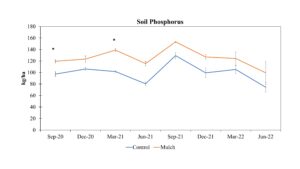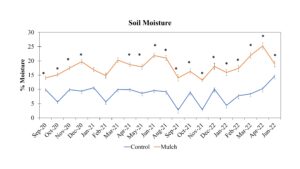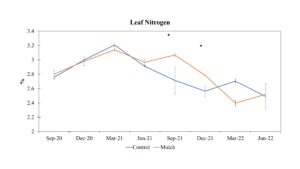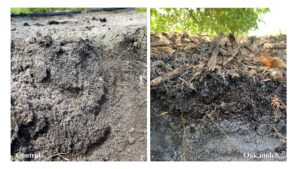Final report for GS20-225
Project Information
Huanglongbing (HLB; also known as citrus greening) is a bacterial disorder that is severely reducing global citrus production. It is caused by the bacterium Candidatus Liberibacter asiaticus (CLas) and vectored by the Diaphorina citri psyllid. It was first detected in Florida in 2005 and is now widely distributed throughout the commercial citrus-growing regions. As of today, there is no cure for HLB, and there are no commercial citrus cultivars, varieties, or scion-rootstock grafting combinations with natural resistance to infection. Thus, searching for alternative mitigation strategies is an urgent priority for a sustainable citrus industry. Anecdotal reports from Florida growers have claimed that citrus growing within the drip line of large oak trees have minimal HLB symptoms, while citrus trees nearby but not under the oak tree drip line have severe symptoms. As a result, some growers are now using oak mulch in their citrus groves, and they noticed an overall increase in production. Following these observations, the main objectives of this study are (i) to study the capability of oak mulch to contain and suppress CLas, (ii) to measure the effect of oak mulch on HLB-affected citrus physiology, and root growth and development, and (iii) to study the effect of oak mulch on the rhizobiome. Soil, leaf, and root samples were collected monthly, along with root images. Overall, oak mulch led to increases in soil moisture, soil phosphorus, soil potassium, and soil magnesium. Additionally, oak mulch increased diversity and microbial biomass in the rhizosphere. However, oak mulch did not greatly impact root growth and was not effective at suppressing HLB.
- Study the capability of oak mulch to contain and suppress CLas
- Measure the effect of oak mulch on HLB-affected citrus physiology and root growth and development
- Study the effect of oak mulch on microbial life biodiversity within the rhizosphere (rhizobiome)
Cooperators
- (Researcher)
Research
This project aimed to apply oak bioactive materials (mulch) in a CLas-infected citrus grove. We reached an agreement with a cooperator offering the use of a part of their existing citrus grove for this project. The study site was part of a larger orange grove, and the trial utilized only Valencia oranges on US-812 (4 years old). This rootstock/scion combination was selected for its sensitivity to low soil and water quality and because is the typical combination used by growers across the Indian River Region. The experimental design for the study was a randomized complete block design where the main variable was the presence of oak mulch (300 kg of mulch per plot). All other grove management operations, including fertilization, irrigation, and pest control was managed by the grower cooperator in accordance with industry standards. Each plot had 4 trees from which canopy growth assessment, root/tree health, disease severity/incidence, soil and leaf nutrient characterization, and soil microbial activity will be assessed. All treatments were replicated 3 times.
Oak mulch was obtained from a landscape company and was chipped and applied to the field at the beginning of the experiment. A second mulch application was conducted 1 year after the start of the project. Lastly, measurements for this project included a wide range of soil physical, chemical, and biological parameters, root parameters, tree physiological assessments, and rhizosphere observations. The measurements and methods pertaining to each objective are discussed below:
Objective 1- Study the capability of oak mulch to contain and suppress CLas in vivo under field conditions.
Leaf CLas titer was sampled at the start of the project and monthly for the duration of the project. Leaves were collected, and the microbial DNA was extracted using the Qiagen DNeasy kit. Changes in individual tree CLas quantities were tracked and analyzed throughout the duration of the experiment. Tree data was analyzed using R to determine if there are treatment effects among the two treatments.
Objective 2- Measure the effect of oak mulch on HLB-affected citrus leaf physiology and root growth, development and physiology.
Root growth was assessed using minirhizotrons installed in each plot (at least 2 per plot) at a 45° angle throughout the root system. A CID-root imager camera (CID Bio-Science, USA) was used to take root scans and estimate root diameter, length, and overall root growth. Root health was assessed using minirhizotron scans and root collections in combination with WHINRhizoTRON analysis software (Regent Instruments Inc., Canada). In addition, leaf, and soil nutrient concentrations (N, P, K, Ca, Mg, S, B, Zn, Mn, Fe, Cu) was determined at the start of the project and at approximately 1-month intervals for the duration of the project. Samples were collected and sent to Waters Ag Laboratories in Camilla, GA for analysis of nutrients, pH, and CEC. Finally, soil moisture analysis between treatments was taken monthly.
Objective 3- Study the effect of oak mulch on microbial life within the rhizosphere (rhizobiome).
A subsample of soil and mulch was collected for rhizobiome analysis. Soil samples containing citrus roots were collected at the beginning of the experiment, after one year and at the end of the field trials. The microbial rRNA was extracted from soil samples using the Qiagen DNeasy PowerLyzer PowerSoil Kit and soil microbial diversity and composition was assessed using high-throughput amplicon sequencing. Extracted rRNA was sent for high-throughput amplicon and shotgun metagenomics sequencing to the University of Illinois Chicago DNA Services Center. Data was analyzed in QIIME 2, Phyloseq and Spieceasy R packages, and PICRUSt. Machine learning algorithms were used to identify specific taxa responsible for differences among treatments and determine their importance in correlation with the measured soil nutrient and tree health parameters.
Objective 1: All trees regardless of treatment showed HLB symptoms at the beginning and conclusion of the experiment. Additionally, leaf Ct values (less than 30) indicated infection at both the beginning and conclusion of the study. Leaf Ct values did fluctuate between 24 and 32 throughout the study. Some differences were observed between treatments. The control treatments had higher Ct values in the spring of 2021 and summer 2022 compared to the mulch treatments, however, no consistent pattern was established. Overall, the oak mulch treatment did not contain or suppress HLB.
Objective 2: Early root density sampling (January 2021) showed increased root growth in mulched plots compared to control plots. Additional root density samplings in June 2021, January 2022, and June 2022 showed no statistically significant differences between mulched in control plots. Minirhizotron sampling showed increased root count and average root length in January 2020. Additionally, average root diameter tended to be higher in control plots compared to mulched plots. These differences were not statistically significant.
Soil analysis showed 20%-30% increases in phosphorus during the September 2020 and March 2021 sampling periods (Figure 1), 48%-88% increase in potassium during the September 2020, December 2020, and June .2022 sampling periods, and a 60%-84% increase in magnesium during the September 2020, December 2020, and March 2021 time points in mulched plots compared to non-mulched plots. Soil moisture levels were consistently significantly higher in mulched plots compared to the control plots. This difference ranged from 25%-85% (Figure 2). No differences were observed in leaf phosphorus or magnesium contents, soil pH, and soil cation exchange capacity between treatments.
Leaf sampling showed 8%-12% increases in nitrogen during the September 2021 and December 2021 sampling in trees treated with mulch compared to the control (Figure 3). Leaf potassium levels were 17% higher in mulched trees compared to control in March 2021. However, during the December 2021 sampling, potassium levels in the control leaves were 6% higher compared to the mulched trees.



Objective 3: More biological activity (soil fauna and flora: mushrooms, worms, etc.) was visually observed in mulched plots (Figure 4). Soil microbiome analysis revealed higher total bacteria count and α- and β-diversity in mulched plots compared to the control.

Conclusions
Overall oak mulch led to an increase in soil quality but did not reduce or suppress HLB. Increases in soil nutrients were not consistently statistically significant, however, mulched plots tended to have higher amounts of nitrogen, phosphorus, and potassium throughout the study. These higher nutrient contents were likely due to both the breakdown of the oak mulch as well as higher retainment of already present soil nutrients. The higher soil moisture contents found in the oak mulch were likely caused by a reduction of evaporation from the soil. This increased moisture likely resulted in the higher microbiome diversity observed in mulched plots. Although mulch increased soil quality, no improvements in root growth or leaf Ct values were observed. Oak mulch did not display curative properties on HLB-affected trees and improvements to soil quality did not result in lower HLB symptoms. It is likely that the antibacterial compounds found in oak leaves are not present in high enough concentrations in the woody parts of oak trees to provide antibacterial effects on HLB-affected trees.
Educational & Outreach Activities
Participation Summary:
On-Farm demonstration
Gave a 30-minute presentation to between 20-40 growers, extension, and industry professionals at the Central Florida Citrus Under Protective Screening (CUPS) Field Day. This event was organized by the Volusia County extension and took place at Vo-LaSalle Farms, Inc (De Leon Springs, FL) on March 25, 2021. Topic included rationale behind the oak mulch study, experimental design/ materials and methods, and preliminary results of the study.
2022 Citrus Show
Gave a 15-minute presentation to between 30-50 growers, extension, research, and industry professionals at the 2021 Citrus Show. This event was organized by the University of Florida and took place at the Harvert L.-Finn center in Ft. Pierce, FL on January27, 2022. Topics included the impact of oak mulch on soil health and the microbiome.
Professional Society oral presentations
- Santiago JM, Hallman LM, Rossi L. Impacts of oak mulch amendments on rhizosphere microbiome of sweet orange trees grown in Florida flatwood soils. Proceedings of the ASHS Annual Conference, July 30-August 3, 2022, Chicago, IL.
- Hallman LM, Shatters RG, Dorado C, Rossi L. 2021. Oak mulch applications improved soil characteristics in an HLB-affected citrus grove. Proceedings of the FSHS Annual Meeting, September 26-28, 2021, Daytona Beach, FL
- Hallman LM, Shatters RG, Dorado C, Rossi L. 2021. Impact of oak mulch on Florida Flatwoods soil characteristics and nutrient uptake of HLB-affected citrus. Proceedings of the ASHS Annual Conference, September 26-28, 2021, Denver, CO
Project Outcomes
Ideally, this project will contribute to the knowledge regarding the use of mulch in the citrus industry. Economically, if the addition of mulch increases plant available nutrients, growers may be able to use less synthetic fertilizers, contributing to economic and environmental sustainability.
The project began in September 2020 and since, our knowledge, skills, and awareness of sustainable agriculture has increased. In only 6 months, improvements in soil nutrient levels due to the application of mulch has been evident. We originally hypothesized that changes in nutrient levels may take years to manifest, however, these preliminary results have taught us that the breakdown of mulch happens much quicker than anticipated.